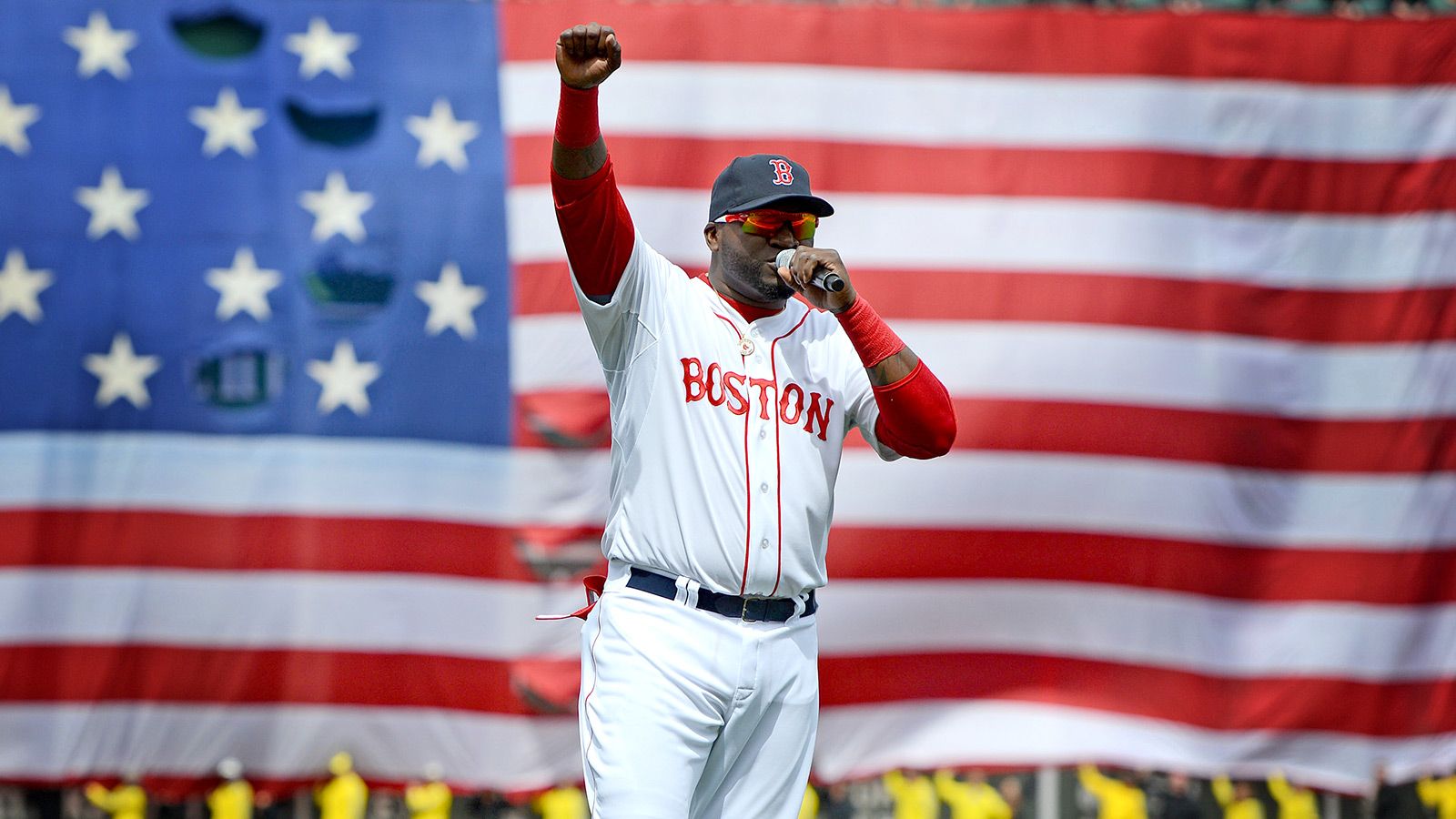Designated hitter is the final position to cover for Red Sox all-time greats. This is a spot that has had a lot of turnover since it came into existence, aside from a certain lovable Papi. The DH did not come into existence until 1973. Many guys have only played for two to three years as the primary DH on the Sox as Big Papi took up about one-fourth of that time. Keeping with the theme of these articles, here are the five greatest in Red Sox history.
David Ortiz
We can thank the Twins for one of the greatest players in franchise history, and maybe the most influential. Ortiz had shown promise with the Twins, posting an .818 OPS over his last three seasons. He hit 20 home runs in 2002 while posting a .500 slugging percentage. I remember thinking it was strange when they let him go and I wanted the Red Sox to sign him. Of course, nobody could have predicted the levels of success yet to come.
There are too many feats to list them all, but Big Papi helped the Red Sox to their first three World Series Championships in 86 years. When finally elevated into the lineup in 2003 over the terrible Jeremy Giambi, (took you long enough Grady Little!) Ortiz raked, hitting .293 with 29 homers and a 1.010 OPS from June 1st on. With his clutch hitting he managed to enter the MVP race, ultimately finishing 5th. It was the first of five consecutive seasons in which Ortiz would place in the top five for the MVP. Ortiz finished in 2nd and 3rd place once and in 4th place twice. In 2006 he set the franchise single-season record by hitting 54 home runs.
Of course there was all the timely hitting. Ortiz had walk-off hits in both game 4 and game 5 of the 2004 ALCS. This came after Ortiz took Jarrod Washburn over the green monster to walk-off the Angels and complete the ALDS sweep. For a stretch there it seemed like whenever he came up with a chance to win the game, he would. I remember watching one game in particular against the Indians; my brother called for Ortiz to hit a home run for the walk-off. My response was, “come on, he’s not going to continue to hit a home run every time, it isn’t possible.” Ortiz promptly took Fausto Carmona over the center field wall to win the game. He was simply unreal, the most clutch player I have ever watched.
Ortiz batted .290 and hit 483 home runs as a member of the Red Sox. He drove in 1530 runs, bashed 524 doubles and had a .386/.570/.956 slash line. Ortiz made 10 All-Star Games and won seven Silver Sluggers. Of course, he went out on top of his game still, batting .315 with 38 home runs and a league leading 48 doubles at the age of 41. In the playoffs, Ortiz hit 17 home runs and had a .947 OPS. They say good pitching beats good hitting in the playoffs, but Ortiz’ postseason numbers are right in line with his regular season ones. He then stepped it up even further in the World Series, batting .455 with a 1.372 OPS over three separate World Series.
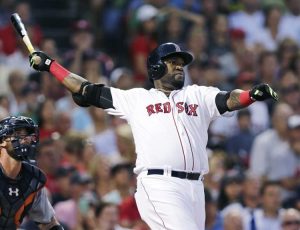
Reggie Jefferson
Jefferson came to the Red Sox without a true role. The Sox already had Mo Vaughn at first base and Jose Canseco at DH. Jefferson ended up forcing his way into the lineup by hitting line drives all over the yard. His emergence may have played a role in Canseco being shipped out-of-town after the 1996 season. That year, Jefferson batted .347 with 19 home runs and a .981 OPS! He had the 2nd highest batting average in the American League and the highest OPS on the Red Sox that season.
Jefferson batted .319 as the primary DH in 1997, hitting .352 against right-handers. He again batted over .300 in 1998 before a back injury shelved him for the remainder of the season in mid-July. In five seasons with the Red Sox, Jefferson batted .316 with a .363/.505/.868 slash line. He was even better in front of the home crowd, hitting .345 with a .928 OPS at Fenway Park. You can read more about him here.
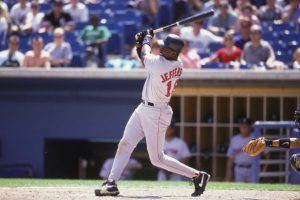
Reggie Jefferson #18 of the Boston Red Sox bats during a game against the White Sox on July 1, 1997 at New Comiskey Park in Chicago, Illinois. (Photo by Mitchell Layton/Getty Images)
Jose Canseco
Canseco was a beast at the plate during his two years with the Red Sox; when healthy. Canseco only played in 102 and 96 games in his two seasons, battling injuries. In his time on the field, Canseco managed to bat .298 with 52 home runs and a .960 OPS. Of course, he had some added help, but those are some monster numbers. If he could have stayed healthy he would have threatened 40 home runs both years.
Canseco batted behind Mo Vaughn in the order, providing him with some lineup protection. Teams still walked Big Mo to get to Canseco occasionally, and it seemed like whenever they did Canseco hit one onto Landsdowne Street. I used to think he would get angry in the on-deck circle at the disrespect. He ultimately slots in third on this list since he was only with the team for two years, but they were two very good offensive seasons.
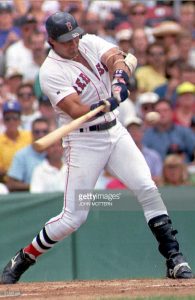
Jose Canseco of the Red Sox drives in a run in the first inning of Boston’s game against the Yankees at Fenway Park. Canseco also had a home run and a tie-breaking two-run double as the Red Sox beat the Yankees 7-4. (JOHN MOTTERN /AFP/Getty Images)
Mike Easler
Easler is another guy who only spent two seasons with the Red Sox. There really aren’t many primary designated hitters who lasted for a while with the team. Easler’s 337 base hits actually rank 5th among Red Sox designated hitters. He batted .288 with 43 home runs and 165 runs batted in on the strength of his first season with the team. In 1984 he was great, hitting .313 with 27 homers and 91 RBI. And that, oddly enough for a position dedicated to guys who can hit, is good enough to make the top five.
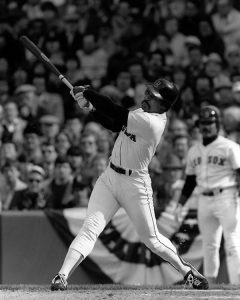
April 13, 1984: Mike Easler bats during the Red Sox home opener against the Detroit Tigers on April 13, 1984.
(Photo by Peter Travers/Boston Red Sox)
Cecil Cooper
Cooper is a guy who should have been with the team longer than he was. An upcoming prospect coming off two solid seasons, the Red Sox traded the 27-year-old Cooper to Milwaukee. Boston brought back two former Red Sox on the wrong side of 30 in George Scott and Bernie Carbo. Scott and Carbo both had one more good season, Cooper went on to bat .302 over 11 seasons with the Brewers.
Before he was traded, Cooper had batted .283 with 40 home runs and a .772 OPS. His best season with the Sox was definitely in 1975, batting .311 with an .899 OPS. He was one of the team’s hottest hitters that summer before taking a pitch to the face in September. Although he would become a Gold Glover in Milwaukee, he was not considered to be a good fielder in his younger days so he had been relegated to DH.
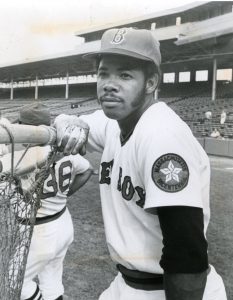
Honorable Mentions:
Carl Yastrzemski (.264 46 HR .764 OPS at DH), Don Baylor, Andre Dawson
